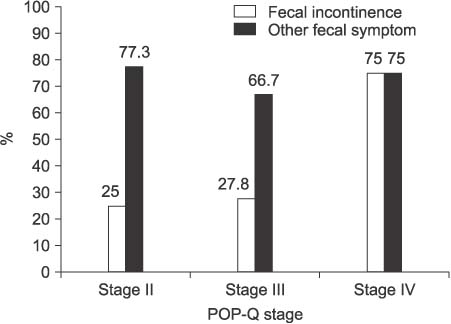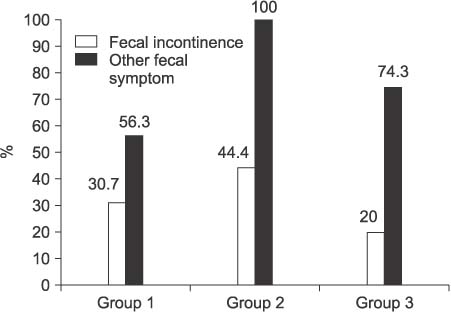Korean J Urol.
2006 Dec;47(12):1339-1347. 10.4111/kju.2006.47.12.1339.
Prevalence of the Urinary and Fecal Symptoms in Women with Pelvic Organ Prolapse
- Affiliations
-
- 1Department of Urology, Soonchunhyang University College of Medicine, Bucheon, Korea. yhkuro@schbc.ac.kr
- 2Department of General Surgery, Soonchunhyang University College of Medicine, Bucheon, Korea.
- KMID: 2139781
- DOI: http://doi.org/10.4111/kju.2006.47.12.1339
Abstract
- PURPOSE
A pelvic organ prolapse (POP) has various pelvic symptoms, including urinary and fecal incontinence. However, the accurate prevalence and problems in South Korea are not well known. The purpose of this study was to determine the relationship of pelvic floor symptoms in patients with a POP.
MATERIALS AND METHODS
Between March 2003 and March 2004, 74 consecutive patients, with over stage II POP quantification (POP-Q) staging, were enrolled. No abnormal neurological signs were detected in 66 women after evaluation. On physical examination, these 66 patients were divided into 3 groups (A=cystocele only, B=rectocele only and C=cystocele rectocele).
RESULTS
The prevalence of urinary incontinence was 28.8%, and with fecal incontinence was 9.1%. The prevalence of fecal incontinence and fecal symptoms, with the exception of fecal incontinence were 28.8 and 74.2%, respectively. With regard to the stage of POP-Q, fecal incontinence (II= 25.0%, III=27.8%, IV=75.0%) and fecal symptoms (II=77.3%, III=66.7%, IV =75.0%) were observed. Each group presented with fecal incontinence (A=38.4%, B=44.4%, C=20%) and fecal symptoms (A=56.3%, B=100%, C=74.3%).
CONCLUSIONS
In this study, the prevalence of urinary incontinence was 28.8%, that of fecal incontinence was 28.8% and that of both urinary and fecal incontinence was 9.1%. The mixed symptoms may cause a dilemma in relation to the formal treatment. Our study suggests urologists should be aware of coexisting fecal symptoms associated with a pelvic organ prolapse.
Keyword
MeSH Terms
Figure
Reference
-
1. Kobashi KC, Leach GE. Pelvic prolapse. J Urol. 2000. 164:1879–1890.2. Petros PE. Application of theory to surgical management of female pelvic floor disorders. The Pelvic Floor. 2002. Philadelphia: W.B. Saunders;417–428.3. Bump RC, Mattiasson A, Bo K, Brubaker LP, DeLancey JO, Klarskov P, et al. The standarization of terminology of female pelvic organ prolapse and pelvic floor dysfunction. Am J Obstet Gynecol. 1996. 175:10–17.4. Burgio KL, Matthews KA, Engel BT. Prevalence, incidence and correlates of urinary incontinence in healthy, middle-aged women. J Urol. 1991. 146:1255–1259.5. Diokno AC, Brock BM, Brown MB, Herzog AR. Prevalence of urinary incontinence and other urological symptoms in the noninstitutionalized elderly. J Urol. 1986. 136:1022–1025.6. Herzog AR, Diokno AC, Brown MB, Normolle DP, Brock BM. Two-year incidence, remission, and change patterns of urinary incontinence in noninstitutionalized older adults. J Gerontol. 1990. 45:M67–M74.7. Denis P, Bercoff E, Bizien MF, Broker P, Chassagne P, Lamouliatte H, et al. Prevalence of anal incontinence in adults (in French). Gastroenterol Clin Biol. 1992. 16:344–350.8. Sandler RS, Drossman DA. Bowel habits in young adults not seeking health care. Dig Dis Sci. 1984. 32:841–845.9. Drossman DA, Sandler RS, McKee DC, Lovitz AJ. Bowel patterns among subjects not seeking health care. Use of questionnaire to identify a population with bowel dysfunction. Gastroenterology. 1982. 83:529–534.10. Allen RE, Hosker GL, Smith AR, Warrell DW. Pelvic floor damage and childbirth: a neurophysiological study. Br J Obstet Gynaecol. 1990. 97:770–779.11. Gilpin SA, Gosling JA, Smith AR, Warrell DW. The pathogenesis of genitourinary prolapse and stress incontinence of urine. A histological and histochemical study. Br J Obstet Gynaecol. 1989. 96:15–23.12. Berglas B, Rubin IC. Study of the supportive structures of the uterus by levator myography. Surg Gynecol Obstet. 1953. 97:677–692.13. Delancey JO, Hurt WW. Size of the urogenital hiatus in the levator ani muscles in normal women and women with pelvic organ prolapse. Obstet Gynecol. 1998. 91:364–368.14. Womack NR, Morrison JF, Williams NS. The role of pelvic floor denervation in the aetiology of idiopathic faecal incontinence. Br J Surg. 1986. 73:404–407.15. Parks AG, Porter NH, Hardcastle J. The syndrome of the descending perineum. Proc R Soc Med. 1966. 59:477–482.16. Kahn MA, Breitkopf CR, Valley MT, Woodman PJ, O'Boyle AL, Bland DI, et al. Pelvic Organ Support Study (POSST) and bowel symptoms: straining at stool is associated with perineal and anterior vaginal descent in a general gynecologic population. Am J Obstet Gynecol. 2005. 192:1516–1522.17. Henry MM. Pathogenesis and management of fecal incontinence in the adult. Gastroenterol Clin North Am. 1987. 16:35–45.18. Thomas TM, Egan M, Walgrove A, Meade TW. The prevalence of faecal and double incontinence. Community Med. 1984. 6:216–220.19. Borrie MJ, Davidson HA. Incontinence in institutions: costs and contributing factors. CMAJ. 1992. 147:322–328.20. Parks A, Swash M. Denervation of the anal sphincter causing idiopathic anorectal incontinence. J R Coll Surg Edinb. 1979. 24:94–96.21. Sultan AH, Kamm MA, Hudson CN, Thomas JM, Bartram CI. Anal-sphincter disruption during vaginal delivery. N Engl J Med. 1993. 329:1905–1911.22. Jorge JM, Wexner SD. Etiology and management of fecal incontinence. Dis Colon Rectum. 1993. 36:77–97.23. Snooks SJ, Setchell M, Swash M, Henry MM. Injury to innervation of pelvic floor sphincter musculature in childbirth. Lancet. 1984. 2:546–550.24. Jackson SL, Weber AM, Hull TL, Mitchinson AR, Walters MD. Fecal incontinence in women with urinary incontinence and pelvic organ prolapse. Obstet Gynecol. 1997. 89:423–427.
- Full Text Links
- Actions
-
Cited
- CITED
-
- Close
- Share
- Similar articles
-
- Measurement of Postvoid Residual Volume in Advanced Pelvic Organ Prolapse Classified by Pelvic Organ Prolapse Quantification[POP-Q]
- Prevalence and Risk Factors of Urinary/Anal Incontinence and Pelvic Organ Prolapse in Healthy Middle-Aged Iranian Women
- Incidence of Concomitant Procedures for Pelvic Organ Prolapse and Reconstruction in Women Who Undergo Sling Operation for Stress Urinary Incontinence
- Diagnosis and treatment of Pelvic Organ Prolapse
- Surgical treatments for vaginal apical prolapse




